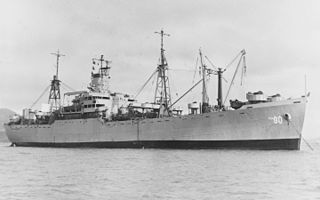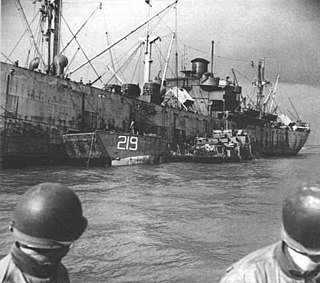
SS A. Frank Lever was a Liberty ship built in the United States during World War II. Her namesake was A. Francis "Frank" Lever. Her sponsor was Mrs. A. Frank Lever.
SS A. Mitchell Palmer (MCE-2436) was an EC2-S-C1 Type Liberty ship design cargo ship, named after U.S. Attorney General Alexander Mitchell Palmer. The ship's keel was laid by Southeastern Shipbuilding Corporation of Savannah, Georgia, on 17 December 1943, commissioned as part of the Second World War effort by the War Shipping Administration (WSA). It was launched 12 February 1944. It was scrapped in 1968 in Taiwan.

Type C2 ships were designed by the United States Maritime Commission (MARCOM) in 1937–38. They were all-purpose cargo ships with five holds, and U.S. shipyards built 328 of them from 1939 to 1945. Compared to ships built before 1939, the C2s were remarkable for their speed and fuel economy. Their design speed was 15.5 knots (28.7 km/h), but some could make 19 knots (35 km/h) on occasion. The first C2s were 459 feet (140 m) long, 63 feet (19 m) broad, and 40 feet (12 m) deep, with a 25-foot (8 m) draft. Later ships varied somewhat in size. Some, intended for specific trade routes, were built with significant modifications in length and capacity.

SS John Stagg was a tanker-type (Z-ET1-S-C3) Liberty ship built at the Delta Shipbuilding Company, New Orleans, Louisiana, during World War II. She was named after John Stagg (1864–1915), who was President of Alabama Presbyterian College for Men.

The Type C4-class ship were the largest cargo ships built by the United States Maritime Commission (MARCOM) during World War II. The design was originally developed for the American-Hawaiian Lines in 1941, but in late 1941 the plans were taken over by the MARCOM.

Park ships were merchant steamships constructed for Canada’s Merchant Navy during the Second World War. Park ships and Fort ships were the Canadian equivalent of the American Liberty ships. All three shared a similar design by J.L. Thompson and Sons of Sunderland, England. Fort ships had a triple expansion steam engine and a single screw propeller. Fort ships were ships transferred to the British government and the Park ships were those employed by the Canadian government, both had the similar design. Park ships were named after local and National Parks of Canada. A few Park ships were launched as "Camp ships", named after Canada military camps, but were quickly renamed after Parks. Jasper Park was the first Park ship lost to enemy attack, in the Indian Ocean after a torpedo attack from U-177 in the Indian Ocean, South of Durban, South Africa.
SS Gracechurch was a UK 4,318 GRT cargo ship built by William Doxford & Sons at Pallion on Wearside in 1930. She twice changed owners and names, becoming SS Peebles in 1933 and SS Mill Hill in 1936. She was sunk by a German submarine in August 1940.

Furness Bermuda Line was a UK shipping line that operated in the 20th century. It was part of Furness, Withy and ran passenger liners between New York and the British Overseas Territory of Bermuda from 1919 to 1966.

SS Queen of Bermuda was a British turbo-electric ocean liner that belonged to Furness, Withy & Co Ltd. Its Furness Bermuda Line subsidiary operated her between New York and Bermuda before and after the Second World War. During the war she served as first an armed merchant cruiser and then as a troop ship.

SS Alexander Majors was a Liberty ship built for the United States Maritime Commission during World War II. The ship was named in honor of Alexander Majors an American who with William Hepburn Russell and William B. Waddell founded the Pony Express. The ship was assigned by the War Shipping Administration to Isthmian Steamship Company of New York who operated it throughout World War 2. Alexander Majors was Laid down on 27 December 1943, launched on 20 January 1944 and completed on 4 March 1944, with the hull No. 2262 as part of the Emergency Shipbuilding Program.

SS Jeremiah M. Daily was a Liberty ship built for the United States Maritime Commission during World War II. The ship was named in honor of Jeremiah M. Daily, (1871-1924) who was the manager of marine department of the San Francisco Chamber of Commerce. Jeremiah M. Daily inspired Jerry Dooley and the Affairs of Cappy Ricks. The ship was assigned by the War Shipping Administration to American South African Line of New York who operated it throughout World War II. Jeremiah M. Daily was laid down on 18 July 1943, launched on 9 August 1943 and completed on 22 August 1943, with the hull No. 1724 as part of the Emergency Shipbuilding Program, built is 35 days.

SS Ralph A. Cram was an American Liberty ship built in 1943 for service in World War II. Her namesake was Ralph Adams Cram, an influential American architect of collegiate and ecclesiastical buildings. She was operated by Smith-Johnson Steamship Corporation under charter with the Maritime Commission and War Shipping Administration.

SS India Victory was a Victory ship built and operated as a cargo carrier and troopship in World War II. After the war the ship was used a private cargo ship. She sank on 12 July 1972, ran aground on a Pratas Reef in the South China in Typhoon Susan.

A. H. Bull Steamship Company was a shipping company and passenger liner service founded in New York City in 1902 by Archibald H. Bull (1848-1920). Service started with shipping between New York and Florida. His fleet of ships then added service to other Eastcoast ports. The company is also often called the Bull Lines and the Bull Steamship Line or A. H. Bull & Company. While founded in New York, Bull soon move its headquarter to Peir 5 in Baltimore, Maryland. Bull Lines main Eastcoast ports were: Baltimore, Charleston, Philadelphia, Tampa and Norfolk, Virginia. Oversea ports: Porto Rico, Antwerp, Bordeaux, Hamburg, Bremen, Copenhagen, and West Africa. Bull Steamship Line supported the US war effort for both World War I and World War II, including the loss of ships.
T. J. Stevenson & Company, Inc. was a shipping firm founded in New York City by Thomas J. Stevenson on December 2, 1935. In 1920 Thomas J. Stevenson started working as a ship broker in New York City. Thomas J. Stevenson's father Henery Stevenson worked as a clerk at a shipping firm in New York City starting in 1910. T. J. Stevenson & Company supported the World War II effort by operating United States owned ships. After the war T. J. Stevenson & Company purchased surplus war cargo ships. Thomas J. Stevenson was born in 1892 and died on January 28, 1968.












